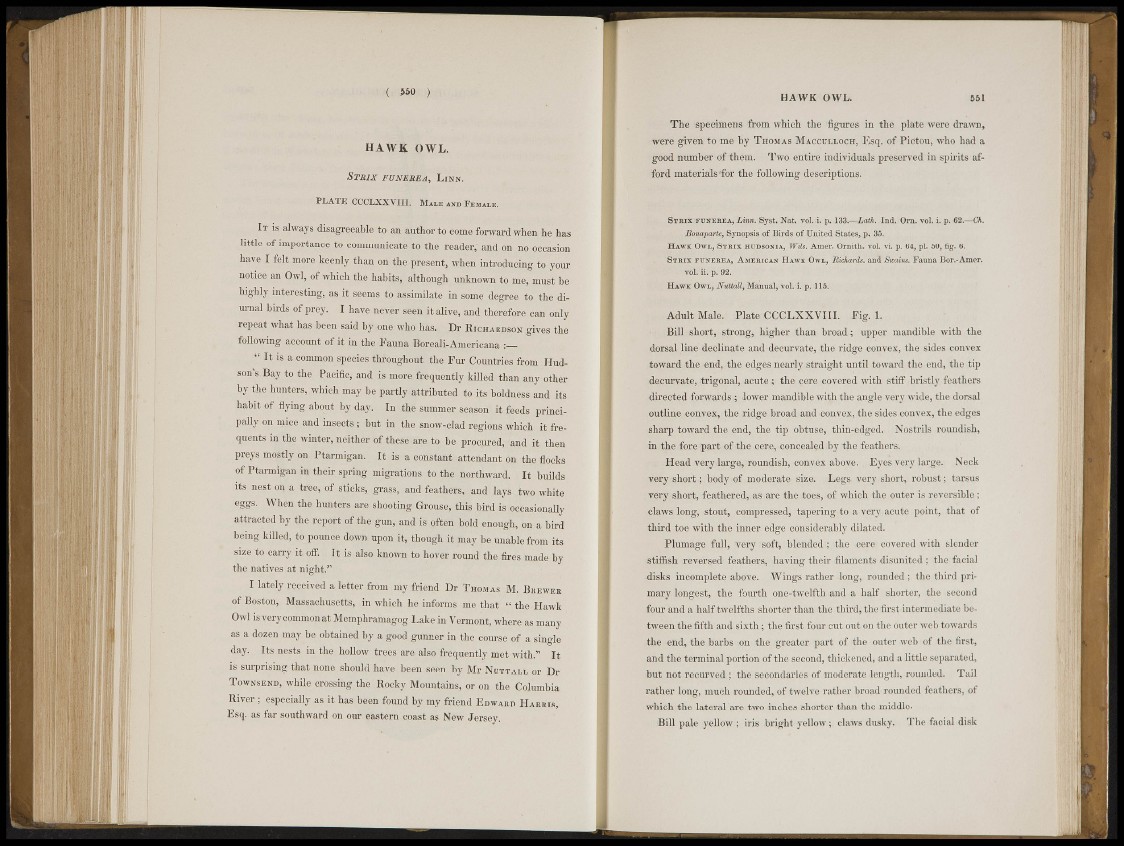
i j j 550 )
HAWK OWL.
STJIIX FU.XMBKA, LINN,
PLATE a : a . x x v i n . ,Msi.k KKM4I.,:.
IT is. always disagreeable tp an author to come forward WK$N ho has
little of importance to <;ommutiicato,to the reader," and on no «coasioii
have I felt mor>e keenly than Ml the present, when introducing to your
w g | e an Owl, of which the habits, although unknown to me, mupt be
Mghjy, ifflterestiiig, as it s,ewns to assimilate in some degree to the J f )
ufnal birds ofj.roy. I haye nevj r seen^it alive, and therefore can only
repeat what has been said by m p who has, Dr RICHARDSON .gives the
follo» ing account of it in tho Fauna lioroali-Americana :—
i(
" It is a common sje'oies throughout the Fur Counto-iS from Huds
" n ' s B'>.V tH th<' I*»eift, and is more frequently killed than any other
by the hunters, which may he partly attributed to 5|s boldness and its
habit of flying^out bfcday. In thg summer season i t ieds principallv
.,1, micro a n d '®smW but in the-Snofeclad regions which it fre-
I'""11" ia ®fwi*ter , neither ®£;&!|| are procured, awl it then
preys nuf | l y on Ptarmigan. It is a constant, .attendant on the focks
of I't;irmi'gan in their spring migration«, to the Northward. It builds
itsgigst a tree, of stìnte, grass, and feathe»^. and layi two white
j | | | | Whén the hunters are Grouse, this bird is occasionally
attracted t>y the report of the gun, and is&ftgi bold enougi, on a bird
being killed, topouneo down upon it, though it may bo unable from its
^ S j t o carry it off. r I t m also known to hover round the fires made by
the natives at night."* -
I lately ivqcrred a letter from my frie.nd Dr THOMAS. M. BUKWEE
of Boston;. Massachusetts, in which he informi, me that " the Hawk
Owl is very common at Momphramagog I.akirin Vermont, whereas many
as a dozen may be obtained by a good gunner in tho course of, a single,
day. Its nfsts in t i e hollow trees aro also frequently met with." It
if surprising that none should have been seen by Mr NMTALL or Dr
TOWNSKX». wliili! crossing thè Rocky Mountains, or on the Columbia
River ; especially as it has boon found fey my friend EDWAEO HARRIS,
Esq, as far southward on our eastern coast as New Jersey
HAWK OWL. 551
The specimens from which the figures in the plate were drawn,
were given to me by THOMAS MACCCLLOCH, Esq. of Pictou, who had a
good number of them. Two entire individuals preserved in spirits afford
materials'for the following descriptions.
STRIX ETTNEREA, Linn. Syst. Nat. vol..i. p. 133.—Lath. Ind. Grn. vol. i. p. 62.—Ch.
Bonaparte, Synopsis of Birds of United States, p. 35.
HAWK OWL, STRIX HUDSONIA, Wils. Amer. Ornith. voL vi. p. 64, pi. 50, fig. 6.
STRIX FUNEREA, AMERICAN HAWK OWL, Richards, and Swains. Fauna Bor.-Amer.
-' ^ol. ii- p. 92.
HAWK OWL, NuttaUj Manual, vol. i. p. 115.
Adult Male. Plate CCCLXXVIII. Fig. 1.
Bill short, strong, higher than broad; upper mandible with the
dorsal line declinate and decurvate, the ridge convex, the sides convex
toward the end, the edges nearly straight until toward the end, the tip
decurvate, ¡trigonal, acute ; the cere covered with stiff bristly feathers
directed forwards ; .lower mandible with the angle very wide, the dorsal
outline convex, the ridge broad and convex, the sides convex, the edges
sharp toward the end, the tip obtuse, thin-edged. Nostrils roundish,
in the fore '.part of the cere* concealed by the feathers.
Head very large, roundish, convex above. Eyes very large. Neck
very short; body of moderate size. Legs very short, robust; tarsus
very short, feathered, as are the toes, of which the outer is reversible ;
claws long, stout, compressed, tapering to a very acute point, that of
third toe with the inner edge considerably dilated.
Plumage full, very ¡soft, blended;; the cere covered with slender
stiffish reversed feathers, having their filaments disunited ; the facial
-disks incomplete above. Wings rather long, rounded ; the third primary
longest, the fourth one-twelfth and a half shorter, the second
four and a half twelfths shorter than the third, the first intermediate between
the fifth and sixth; the first four cut out on the outer web towards
the end, the barbs on the greater part of the outer web of the first,
and the terminal portion of the second, thickened, and a little separated,
but not recurved ; the secondaries of moderate length, rounded. Tail
rather long, much rounded, of twelve rather broad rounded feathers, of
which the lateral are two inches shorter than the middle.
Bill pale yellow ; iris bright yellow; claws dusky. The facial disk